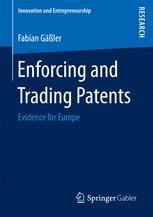Patents are regarded as a key policy instrument to spur innovation and technological progress, based on the social bargain that inventors disclose their novel and nonobvious invention to the public in return for temporary exclusion rights to use the invention. The artificial market power a patent confers upon the inventor with inevitable loss of public welfare represents a fundamental market intervention of the state. Not surprisingly, since the beginning of mod- ern economic thought, scholars have therefore been pondering over the costs and benefits of patents to society. 1 While early scholars focused primarily on the fundamental issue whether intellectual prop- erty rights should exist at all, research has become more and more nuanced over the last century. Starting with the seminal work of Nordhaus (1969), who was the first to consider the length of patent protection a variable parameter in patent policy, questions on the optimal patent length and scope have become a focus of attention (e.g., Gilbert and Shapiro, 1990). However, these models, looking at one isolated invention, have not kept up with the chang- ing technology and patent landscape. First, inventions have become increasingly cumulative, meaning that a patent on one invention has externalities on the incentives for subsequent re- search (Scotchmer, 1991). Second, products have become more complex, comprising multiple components covered by patents in often fragmented ownership (Shapiro, 2001). In this con- text, negotiations on how innovation rents are to be divided between the different parties are necessary to avoid market failure. However, these negotiations may be complicated, because patents are not always perfectly defined property rights (Merges, 1994). In fact, patents can be subject to significant uncertainty regarding their scope and validity (Lemley and Shapiro, 2005). First, patent boundaries can be vague for new technologies or abstract inventions, such as biotechnology, business methods, and software (Bessen and Meurer, 2008).
چکیده فارسی
پتنت ها به عنوان یک ابزار سیاستی کلیدی برای تحریک نوآوری و پیشرفت فناوری در نظر گرفته می شوند، بر اساس معامله اجتماعی که مخترعان اختراع بدیع و غیر آشکار خود را در ازای حق محرومیت موقت برای استفاده از اختراع برای عموم فاش می کنند. قدرت بازار مصنوعی که یک حق ثبت اختراع با از دست دادن اجتناب ناپذیر رفاه عمومی به مخترع اعطا می کند، نشان دهنده مداخله اساسی دولت در بازار است. جای تعجب نیست که از آغاز تفکر اقتصادی مدرن، محققان در مورد هزینه ها و مزایای ثبت اختراع برای جامعه فکر کرده اند. 1 در حالی که محققان اولیه عمدتاً بر این موضوع اساسی تمرکز کردند که آیا حقوق مالکیت فکری اصلاً باید وجود داشته باشد یا خیر، تحقیقات در طول قرن گذشته بیشتر و بیشتر شده است. با شروع کار اصلی نوردهاوس (1969)، که اولین کسی بود که طول حفاظت از حق ثبت اختراع را یک پارامتر متغیر در خط مشی ثبت اختراع در نظر گرفت، سؤالات مربوط به طول و دامنه بهینه ثبت اختراع به کانون توجه تبدیل شده است (به عنوان مثال، گیلبرت و شاپیرو، 1990). با این حال، این مدلها، با نگاهی به یک اختراع مجزا، با فناوری در حال تغییر و چشمانداز ثبت اختراع سازگاری ندارند. اولاً، اختراعات به طور فزایندهای انباشته شدهاند، به این معنی که یک حق ثبت اختراع روی یک اختراع دارای اثرات خارجی بر انگیزههای تحقیقات بعدی است (اسکاچمر، 1991). دوم، محصولات پیچیدهتر شدهاند و شامل اجزای متعددی هستند که توسط پتنتها در مالکیت غالباً پراکنده پوشش داده میشوند (شاپیرو، 2001). در این زمینه، مذاکرات در مورد چگونگی تقسیم رانت های نوآوری بین طرف های مختلف برای جلوگیری از شکست بازار ضروری است. با این حال، این مذاکرات ممکن است پیچیده باشد، زیرا ثبت اختراع همیشه حقوق مالکیت کاملاً تعریف شده نیستند (Merges, 1994). در واقع، پتنت ها می توانند در معرض عدم قطعیت قابل توجهی در مورد دامنه و اعتبار خود باشند (لملی و شاپیرو، 2005). اول، مرزهای ثبت اختراع می تواند برای فناوری های جدید یا اختراعات انتزاعی، مانند بیوتکنولوژی، روش های تجاری، و نرم افزار مبهم باشد (Bessen and Meurer, 2008).
ادامه ...
بستن ...
Author(s): Fabian Gäßler (auth.)
Series: Innovation und Entrepreneurship
Publisher: Gabler Verlag, Year: 2016
ISBN: 978-3-658-13374-0, 978-3-658-13375-7
ادامه ...
بستن ...










